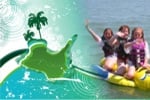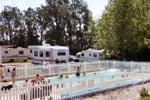SOUTH BASS ISLAND STATE PARK
The family campground features 125 non-electric sites, and 10 full service sites with electric, water and sewer hook-ups. The campground offers flush toilets, showers, and a dump station. Pet camping is permitted on designated sites. A youth group camp is available by reservation for organized groups. Four cabents, combining the best features of a cabin and tent, are available through a lottery system for weekly rental from Memorial Day to the last weekend in September. A separate lottery is held for rental of the rustic cabin located near the park office. Contact the Catawba Island park office for lottery details. A picnic shelter, picnic areas, launch ramp, fishing pier and small stone beach area are also available. South Bass Island is accessible by ferry from Port Clinton or Catawba Island.
Limestone cliffs, historic wineries, crystal caverns and a shimmering Great Lake greet visitors to the Lake Erie Islands state parks. These five state parks offer unique island retreats with an atmosphere both festive and casual. Fishing, boating and swimming can be enjoyed at each park.
Several parks comprise the Lake Erie Island group. The islands were formed during the glacial period when massive ice sheets entered Ohio. Glaciers gouged and scoured the bedrock; their tremendous weight left deep depressions which filled with meltwater, forming the Great Lakes.
Lake Erie, the smallest of the Great Lakes, is shallow--allowing for violent storms with high waves. The lake is divided into three basins. The western basin has an average depth of 25 to 30 feet; the central basin averages 61 feet; and the eastern basin shows an average depth of 120 feet.
Lake Erie has high nutrient levels and warm temperatures which produce greater numbers and varieties of fish than any other Great Lake. Annual catches nearly equal the combined catch of all other Great Lakes. Yellow perch, smallmouth bass, white bass, channel catfish and walleye are dominant species.
The islands are composed of limestone bedrock. Small scratches in the rock surface known as glacial striations are common while major grooves such as those found at Kelleys Island are rare but awesome. Vast stands of red cedar and the presence of underground caverns, both associated with limestone are found here. The islands and shoreline support a variety of reptiles including the state's highest concentration of the harmless fox snake. The timber rattlesnake was at one time quite prevalent on the islands but is now gone from the area. Rattlesnake Island was so named due to the presence of this reptile years ago.
Migrating songbirds rest here before winging across the lake. Hundreds of different species have been identified, making this one of the best birdwatching areas in the country. Several nesting pairs of the magnificent bald eagle are located in the area.
Prior to the War of 1812, the Lake Erie Island region had been occupied by Ottawa and Huron (Wyandot) Indian tribes at different times throughout the years. A testimony to their existence on the islands is carved in Inscription Rock on Kelleys Island. Pictographic writings over 500 years old are etched in this massive limestone boulder.The Ottawa and Huron were eventually moved out by European settlers. The War of 1812 ended the last Indian threat to the European settlement of Ohio. One decisive naval battle of that war was fought in Put-In-Bay, off the shores of South Bass Island. Oliver Hazard Perry with an inferior fleet defeated the British making famous his saying, "We have met the enemy and they are ours." The victory gave the Americans control of Lake Erie and led to the ultimate defeat of the British in that war.
The islands remained sparsely settled until 1854 when J.D. Rivers purchased five of the islands. At first he turned Put-In-Bay into a sheep ranch, having at one time a herd of 2,000, but eventually he converted the island into a fruit farm. Despite the extreme northern location, the islands have the longest frost-free period of any area in Ohio due to the stabilizing effect of the lake.
It soon became apparent to islanders that the cultivation of grapes was very profitable. The grape culture has had a dramatic influence on the islands, sometimes called the "Wine Islands." By 1887, more than one-third of the grape product and nearly one-half of the wine product of the entire state was credited to this area. Wines from these islands were once pronounced by the best judges as being comparable to the best productions of France. Several island wineries still exist today.
In addition to raising fruits, the islands supported other profitable industries. Logging of red cedar, quarrying for limestone and the propagation of fish provided additional means of support.
For over a century, South Bass Island has been famous as a summer resort. Ruins of the Victory Hotel, destroyed by fire in 1919, are still evident. Tourism thrives today making the islands one of the most popular vacation spots in the state. The five areas comprising Lake Erie Island state parks were added to the state park system in the early 1950s.
Ohio does not have an annual pass and does not charge entrance fees to state parks.
GeneralLand, acres32
Water, acresGreat Lake
Day-UseFishingyes
Picnickingyes
Picnic Shelters, #1
BoatingBoating LimitsUnlimited HP
Seasonal Dock Rental20
Launch Ramps, #1
CampingPrimitive, #125
Full Hookup Sites, #10
Pets Permittedyes
Flush Toiletsyes
Dumpstationyes
Showersyes
Camper Cabins, #5
Youth Group Camp, capacity50
WinterIce Skatingyes
Ice Fishingyes

Conference Center
Week long youth camps. Located on the shores of Kelleys Island. Guests will learn to sail, wakeboard, waterski while enjoying the beauty of the Lake Erie island.
7.3 miles from park*





